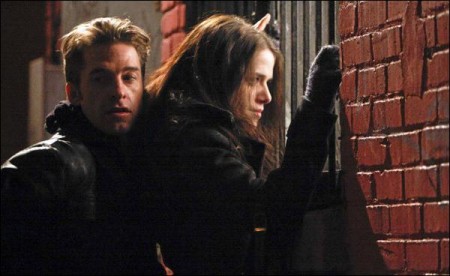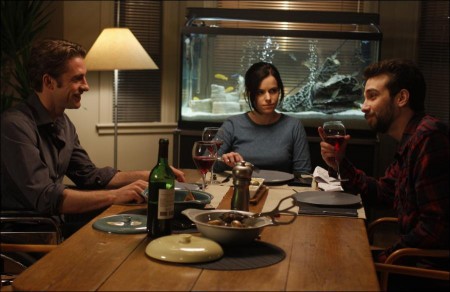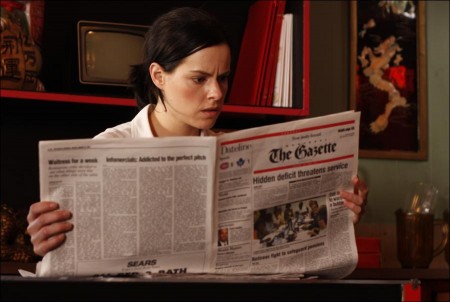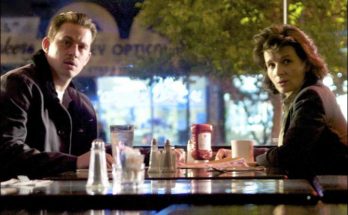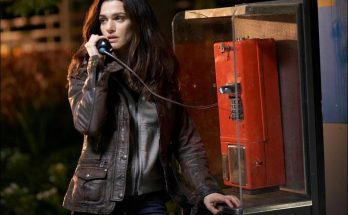Taglines: You never know who’s living right next door.
Neighbors Spencer (Scott Speedman) and Louise (Emily Hampshire) have bonded over their fascination with a recent string of murders terrorizing their community. When a new tenant named Victor (Jay Baruchel) arrives in the building, all three quickly hit it off. But as they soon discover, each of them has their own dark secret.
As the violence outside mounts, the city retreats indoors for safety. But the more time these three spend together in their apartment building, the clearer it becomes that what they once thought of as a safe haven is as dangerous as any outside terrors they could imagine. Smart dialogue, strong performances and jarring thrills give this film all the elements of a great mystery.
About the Film
Chrystine Brouillet’s first novel Chère voisine was originally published in 1982. The book, which chronicled the killings of a series of young women and, more particularly, their repercussions on three residents of a Quebec City apartment complex, distinguished itself with its mix of suspense, shocks and satire. Writer-director Jacob Tierney, who initially read Chère voisine in high school, decided to take the material to his father, Montreal producer Kevin Tierney, with whom he last collaborated on the comedy The Trotsky.
“Jacob told me about this book a long time ago,” recalls the elder Tierney, “and I said, Jacob, I really don’t want to make a movie about a serial killer.” And when we finished shooting on The Trotsky, I sent him a note saying, “I’ll produce any project that you want to make.” And he told me: “this is the one.” The producer overcame his initial reluctance upon reading the novel. “I actually found it way funnier and way more diabolical than just being a book about a serial killer. Don’t get me wrong, it’s still a pretty sick little tale – but there’s great fun to it in a perverse way-.”
“I’m a big noir fan”, enthuses Jacob Tierney. “When I was a kid, I read a ton of Sherlock Holmes and Agatha Christie, and I love mysteries. I love whodunits. So this is a kind of natural extension.” The story isn’t really so much of a whodunit. You kind of know whodunit pretty quickly. It’s more a movie about: what are these people going to do with the information that they have? And that’s what appealed to me about the book.”
The resulting adaptation, rechristened Good Neighbors, recounts the story of the denizen of an urban apartment block, and a serial killer who begins a rampage that has the entire neighborhood rightfully upset. Living above one another on three separate floors, are Spencer (Scott Speedman), wheel-chair bound since the tragic accident some months earlier that left him not only a cripple but a widower as well; Louise (Emily Hampshire), a waitress at a local Chinese restaurant who doesn’t seem to have much interest in anything save her cats (Mozart and Tia Maria), and the newcomer, Victor (Jay Baruchel), an elementary school teacher who has just moved in to complete the film’s central triangle, in what soon becomes not so much a whodunit as a whosgonnagetit.
In writing the screenplay, Jacob Tierney decided to replace the novel’s then-contemporary setting of Quebec City circa 1982, with that of a referendum-era Montreal of 1995. “Science is the death of noir”, the younger Tierney says, regarding his decision to set the film in an era where the Internet and DNA research were not yet widely embraced. He elaborates further on the plight of today’s contemporary thrillers: “If everybody’s got a cell phone, if you even Google something, it’s no fun. It’s no fun! How do you change your passport? You can’t pretend to be somebody else… they know what you look like because you’re on Facebook!”
Juxtaposing his story against the 1995 Quebec referendum, which found the Parti Québécois fighting for a free and independent Quebec (they ultimately lost by a very narrow margin), Jacob Tierney recounts, “That’s when I read the book for the first time. For whatever reason, those two ideas became kind of conflated for me. And I couldn’t really separate them anymore.” In the months leading up to the October referendum, Montreal was covered in posters urging residents to vote either Oui (for separation) or Non. “What’s cool about the referendum, just in terms of signage, is what it articulates visually”, Tierney observes. “Because it’s just yes and no. Just one choice. These are choices that reflect the choices of the character Louise. It’s very simple to her: yes, or no.”
“I thought they were really just fascinating,” recalls actress Emily Hampshire (Snow Cake, The Trotsky) regarding her first impressions of the characters in the book and screenplay, “and I was instantly in love with Louise.” The choices alluded to by Jacob Tierney, above, refer to Louise’s options upon finding her beloved cats, Mozart and Tia Maria, dead in the yard outside her apartment –poisoned by her not-so-friendly neighbor, Valérie Langlois, played to the hilt by Anne-Marie Cadieux (Maman Last Call). Will Louise accept this terrible loss, or will she take matters into her own hands and avenge the murder of her cats by?
“I wrote these parts for Jay Baruchel, Scott Speedman and Emily Hampshire,” Jacob Tierney recounts, “so what was so satisfying about that whole process was actually getting to write with an actor in mind, and then watch it all happen and grow and come to life.”
Jay Baruchel, who played the title character in Jacob Tierney’s comedy The Trotsky, shares his thoughts on his character of Victor, the ill- (or not so ill-) fated pawn in this elaborate game of murder and betrayal: “He’s a lot more intelligent and cunning than he seems”, says the actor. “I also think he’s a lot more intelligent than he thinks he is. Everything about Victor is written on his sleeve. Everything with him is as genuine and earnest as it seems to be. But that doesn’t mean he’s a fool. He believes he’s the man in the white hat. And I think he’s got a set of morals that he abides by.”
Completing this triangle as the mysterious, wheelchair-bound young widower Spencer (Scott Speedman). Speedman was most recently seen in Atom Egoyan’s Adoration and in the sleeper horror hit The Strangers. “I feel like it takes me a full movie to better understand how to direct a particular actor”, says director Tierney. However, “It’s my first time working with Scott, and that’s been terrific too, because I felt an immediate kind of connection with him.” Speedman, meanwhile, has nothing but praise for his director: “Jacob is very comfortable on a set. He’s very at ease and knows what he’s doing. That means he’s more open to taking risks.” The actor continues, “When actors become directors, it’s hit and miss. But when they do make good directors, that’s usually why, and that’s the case here.”
Production on Good Neighbors began on January 18th 2010. Re-joining the Tierneys behind the camera, after their collaboration on The Trotsky, were director of photography Guy Dufaux (Les Invasions barbares), production designer Anne Pritchard (Femme Fatale), sound mixer Claude Hazanavicius (Nitro) and casting director Rosina Bucci (Bon Cop Bad Cop). New faces included costume designer Francesca Chamberland (Maurice Richard), production manager Michel Siry (The Sum of All Fears) and first assistant director Don Terry (Godsend).
Perhaps the biggest challenge faced by the crew was finding the right apartment building to stage not only the climax of the film (set on a fourth-floor fire escape), but to provide the hallways, stairways, and four distinct homes for each of the main characters (our main triangle, plus nasty neighbor Valérie). Location manager Benoit Mathieu, another Trotsky veteran, solved 50% of the equation when he found an old apartment complex just off of Sherbrooke Street, in Notre Dame de Grace proper to the setting. This building would provide all of the exteriors, as well as all interior hallways and staircases as required by the script. The production also rented several vacant apartments, one of which served as the home of the vicious Valérie. Additional apartments were used as green rooms and makeup rooms for the cast, and others were utilized to store equipment. These apartments also provided an ample amount of windows from which to shoot out of, for the wide variety of point-of-view shots required to tell the story. NDG native Baruchel, who lives two blocks from the location, notes: “That’s where I grew up, and I’ve never once seen my neighborhood on film like that. It’s kind of a love letter to the neighborhood in many ways.”
Taking into account that the three apartments inhabited by Victor, Spencer and Louise are stacked above one another and therefore, by nature, architecturally the same, Anne Pritchard and her art department decided to build one single apartment set. Constructed in a warehouse in East End Montreal, the set would be redressed twice over the course of production to serve as three distinct homes representing three very unique personalities. “The work that Anne Pritchard and her team have done is extraordinary”, enthuses director Tierney. False brickwork and very real iron balconies, as well as a giant exterior backdrop (photographed at the real location by cinematographer Dufaux), were added just outside the windows to add to the realism.
Animal trainers Josée Juteau and Raymond Ducasse, of Montreal-based Profilms Animaux, spent several months training the six cats required to portray Mozart, Tia Maria and Balthazar. “We have doubles for each cat,” explains Jacob Tierney, who has nothing but praise for his trainers. “Some cats are better at running and jumping, some cats are better at cuddling, some cats are better at (doing the) different things you need.” Producer Kevin Tierney adds, “We’re shooting a lot of the movie outside, and the weather conditions are not ideal for humans or cats. For (the cats) to do their tricks and show off their skills, in bad weather conditions, it’s a very tough kind of undertaking.”
Emily Hampshire had an unexpected reaction during her first on-camera encounter with Balthazar. “He rubbed his face on me”, recounts the actress, “and he was so cute, and I suddenly felt this fire shoot across my cheek. I broke out in hives.” She went to her director, perplexed by the sudden allergy she developed since first meeting Balthazar in pre-production. Hampshire continues: “Jacob’s like, who did you meet, Citrouille or the other one? I didn’t know there were two cats. I’d met Citrouille. So I think I’m just allergic to Balthazar’s stand-in.” To allow the main unit to move forward, a second unit crew was employed to shoot various inserts of the cats inside and outside the apartment building. Jacob Tierney explains the number one rule when working with animals: “If the cat does it right, that’s going in the movie. So you better make sure everybody else is doing the right thing at the same time too.”
“I think we’ve all had neighbors that we’d like to kill at one point or another”, notes Kevin Tierney. Indeed, when sharing living space with people, be it a building or even a street, chemistry with our neighbors (or lack thereof) can be a very volatile thing. Director Tierney recalls one neighbor in particular, who was not unlike a character in his film: “I had a Victor when I lived in LA. (He was) this really friendly guy, who got too friendly at a certain point. He was very much a Victor.” Adds Hampshire: “Jacob was a very close neighbor of mine, so if anything my relationship with Spencer might be a bit like (my relationship with Jacob).”
Deciding to remain diplomatic, Baruchel admits that “I’ve always gotten along with everybody I’ve lived near, but I’ve shared some apartment floors with some crazy people.” As for producer Tierney, he recalls the theft of a prized pot plant. Claiming that this happened “long ago” (honest!), he waxes poetic on his number one suspect: “There was this kid who looked like Joe Dallesandro, from the Andy Warhol movies. He had a long ponytail, and would always walk around with his shirt off. He would never make eye contact.” He ultimately confesses: “I never killed him. I talked myself out of it. But I wanted to. Because I believe in vengeance.”
Baruchel is grateful for the opportunity to return to Montreal so soon after completing The Trotsky. Indeed, Good Neighbors is a reunion of sorts with much of the previous film’s cast and crew, including the Tierneys, as well as his co-star/love interest Hampshire. When asked about their on-screen relationship in both films, the actor observes, “Like Batman and the Joker, I’m destined to chase her for the rest of my life. Which is fine. There’s a lot worse things I could be doing than chasing a beautiful girl like Emily Hampshire. And to get paid for it doesn’t suck.” For her part, Hampshire (who returned to Montreal between both films to shoot the thriller Die) likens her co-workers to “old friends”. The feeling is mutual for her director: “The fact that the crew is largely the same crew as The Trotsky helps keep things light”, the younger Tierney admits. “We know each other, and there’s a certain formality you skip by working with people the second or third time.”
Production on Good Neighbors wrapped after five weeks, in late February 2010. The post-production process brought back more returnees from The Trotsky, such as editor Arthur Tarnowski (The Wild Hunt), sound designer Pierre-Jules Audet, and post-production supervisor Pierre Thériault (Bon Cop Bad Cop). The score was provided by Silver Mountain Industries (made up of members of Thee Silver Mount Zion and Godspeedyoublackemperor!).
“Character is the action that pushes the plot forward”, notes Jacob Tierney. “That’s what I’m interested in.” Indeed, at its core, Good Neighbors is defined by its diverse cast of characters, and by the elements that each of his actors managed to bring to the table. But as his cast can testify to, it’s a two-way street: “Louise has given me a lot of confidence”, says Hampshire of her character. “If you ask Louise to dinner, she can just say, No. Bye. Whereas I feel a lot of the time, you have to say, Oh, sorry, I can’t, or make up some excuse.”
Regarding his personal and professional relationship with his colleague and son Jacob, Kevin Tierney explains: “It’s really about collaborating, about being on the same page and really wanting to make the same movie. So when you’re in tune as much as that, it really becomes easy.” Producer Tierney pauses. “And you know we can still have dinner on the weekends. I can’t imagine a nicer working relationship.”
Good Neighbours
Directed by: Jacob Tierney
Starring: Jay Baruchel, Scott Speedman, Emily Hampshire, Xavier Dolan, Gary Farmer, Kaniehtiio Horn, Jacob Tierney, Pat Kiely
Screenplay by: Jacob Tierney
Production Design by: Anne Pritchard
Cinematography by: Guy Dufaux
Film Editing by: Arthur Tarnowski
Costume Design by: Francesca Chamberland
Set Decoration by: Frédérique Bolté
Art Direction by: Colombe Raby
MPAA Rating: R for some strong violence, sexual content, graphic nudity and language.
Studio: Magnolia Pictures
Release Date: July 29, 2011
Hits: 189
